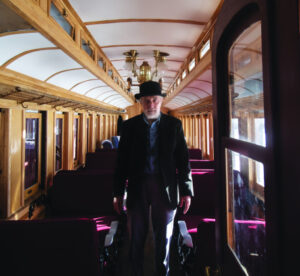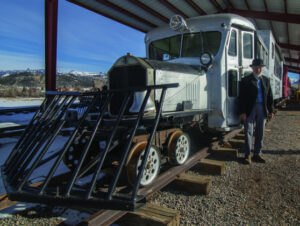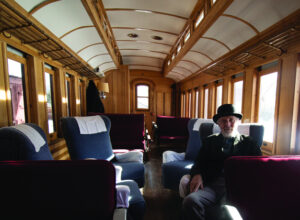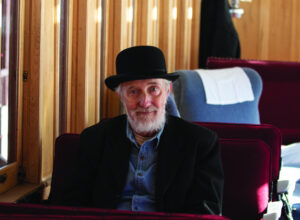
 Karl Schaeffer walks through the Rio Grande Southern 252 railcar at the Ridgway Railroad Museum. It will be pulled by a steam locomotive still under construction, funded by Schaeffer and Chris Weiser of Montrose. Photo by Erin McIntyre
Karl Schaeffer walks through the Rio Grande Southern 252 railcar at the Ridgway Railroad Museum. It will be pulled by a steam locomotive still under construction, funded by Schaeffer and Chris Weiser of Montrose. Photo by Erin McIntyre Karl Schaeffer stands at the Ridgway Railroad Museum with Rio Grande Southern Railroad Galloping Goose No. 4. These machines were also known as “rail motors” and were used to transport mail and handle a few passengers at a lower cost than passenger trains when the company went into bankruptcy in 1930. Schaeffer helped found the railroad museum and hopes he gets to see part of the legacy he’s building there – a brand-new narrow gauge steam locomotive he and Chris Weiser are funding, which he hopes will be fi
Karl Schaeffer stands at the Ridgway Railroad Museum with Rio Grande Southern Railroad Galloping Goose No. 4. These machines were also known as “rail motors” and were used to transport mail and handle a few passengers at a lower cost than passenger trains when the company went into bankruptcy in 1930. Schaeffer helped found the railroad museum and hopes he gets to see part of the legacy he’s building there – a brand-new narrow gauge steam locomotive he and Chris Weiser are funding, which he hopes will be fi Karl Schaeffer sits in the renovated Rio Grande Southern 252 passenger car. Schaeffer, 71, used to camp in the railcar with his family up at Trout Lake as a child, before his parents sold it. Later on, he and his sister purchased the railcar and he donated it to the Ridgway Railroad Museum and led the effort to renovate it with museum volunteers. Erin McIntyre — Ouray County Plaindealer
Karl Schaeffer sits in the renovated Rio Grande Southern 252 passenger car. Schaeffer, 71, used to camp in the railcar with his family up at Trout Lake as a child, before his parents sold it. Later on, he and his sister purchased the railcar and he donated it to the Ridgway Railroad Museum and led the effort to renovate it with museum volunteers. Erin McIntyre — Ouray County Plaindealer Karl Schaeffer sits in the railcar he donated to the Ridgway Railroad Museum, which he used to camp in with family as a child up at Trout Lake. He led the renovation of the railcar with volunteers at the railroad museum. Photo by Erin McIntyre.
Karl Schaeffer sits in the railcar he donated to the Ridgway Railroad Museum, which he used to camp in with family as a child up at Trout Lake. He led the renovation of the railcar with volunteers at the railroad museum. Photo by Erin McIntyre.Editor’s note: This is the latest in an occasional feature we publish about community members who might not otherwise make the news. These include stories about hobbies, service, or just “people stories.” If you have someone you think would make a great “neighbors and helpers” story, email erin@ouraynews.com.
______________________
Karl Schaeffer’s cell phone is filled with pictures of trains – dozens of them documenting the building of a steam engine. He’s like a father keeping track of his child’s accomplishments – but in this case, it’s the first narrow-gauge steam engine of its kind built in the U.S. since 1974.
A replica of a steam locomotive built in 1880, the new Rio Grande Southern 36 is under construction in Palisade. When complete, it will travel around the halfmile narrow gauge track at the Ridgway Railroad Museum, pulling visitors who’ve come to learn about trains and the town’s history.
Schaeffer, 71, is one of two funders of the steam engine, and he’s eagerly awaiting its completion – but he isn’t sure he’ll live to see it run.
The longtime president and de facto director of the museum stepped down from the role last month as he continues treatment for cancer, which started as melanoma three years ago before moving throughout his body.
The steam engine, which he hoped would be completed by now, is the latest part of his legacy: a decades-long commitment to preserving and sharing the stories of Ridgway’s railroading past.
The town was founded as the headquarters for the Rio Grande Southern Railroad.
But Schaeffer, one of six original founders of the museum in 1998, saw that knowledge of the town’s significance slipping away.
“These things, they’re known all over the world,” he said, but part of his mission is to make sure locals understand “Ridgway was more than just a lousy art community.”
“I thought it was a worthy thing to do to remind them that something interesting did happen here,” he said.
***
Schaeffer took his first train ride in Ridgway before he was born.
In August 1951, his parents came to visit on a trip from Oklahoma; his mother was pregnant with him at the time. They paid $11 for two box lunches and two roundtrip tickets to ride Galloping Goose No. 4 up to Lizard Head Pass, and fell in love with what they saw.
They made the decision “on the spot” to move to the area, and settled in Montrose the following year.
The family spent weekends exploring ghost railroads by Jeep and at a “summer cabin” on Trout Lake – which was actually Rio Grande Southern 252, a passenger car built in 1880. His father saw it parked on Dallas Divide in 1952, waiting to be scrapped, and bought it for $150.
After finishing high school in Montrose, Schaeffer left for the Colorado School of Mines on a full scholarship. The son and grandson of electrical engineers, he wanted to pursue mechanical engineering; he left with two degrees.
There were plenty of job options for the new graduate, “but they were all in places I didn’t want to go, and things I didn’t really want to do.” Instead, he landed a spot in the Denver and Rio Grande Railroad’s Special Apprentice program, which launched his career.
Over 22 years, he worked in Denver, Salt Lake City and San Francisco, doing everything from troubleshooting locomotives and going out to wrecks to overseeing hundreds of employees and more than 2,000 cars in the fleet.
His favorite parts were riding trains, hearing and telling old railroad stories and enjoying the views – in one role, he was jokingly called the “scenery inspector.”
Schaeffer stayed on with the company when it purchased Southern Pacific, until a 1996 merger with Union Pacific. Rather than moving to Nebraska, he took a buyout and retired at 45, then made his way back to the San Juans.
***
Since then, he’s devoted himself to the museum, including acquiring and building equipment so people can ride the rails themselves – which he believes is one of the best ways to tell those stories.
His most challenging endeavor was building a replica of Rio Grande Southern Motor 1, often referred to as the Galloping Goose No. 1.
The Geese, also known as rail motors, came about when the RGS Railroad went into bankruptcy in 1930. The seven Geese were built so the company could keep its contract to deliver mail, and handle a few passengers at a lower cost than their passenger trains.
RGS Motor No. 1, the first of the rail motors, was built in Ridgway in 1931, and traveled daily between Telluride and Durango. By the following year, three more were built, and Motor 1 was taken out of service, replaced by the newer and larger machines.
Schaeffer spent seven months and 1,500 hours building a recreation of that first rail motor, using parts from a 1926 Buick Engine he found in Montana. He’s run it at the Colorado Railroad Museum in Golden, and on the Durango & Silverton Narrow Gauge Railroad, as well as giving free rides in Ridgway.
He set out on that project because he didn’t think he had a chance of getting any of the other surviving Geese to the museum, but felt it was important to have one in Ridgway, the birthplace of the flock.
He also helped restore Goose No. 4, which is owned by the Telluride Volunteer Fire Department, and displayed in Ridgway during the off-season.
“There is a remarkably huge population of people in the world that know about Galloping Geese and Ridgway that have never been here,” Schaeffer said. But here, people didn’t know what had happened or why it mattered so much, and he wanted to change that.
“Creative people who do not consider themselves artists do things that add to the quality of all of our lives,” he said. “And the Galloping Goose was a major one.”
The steam engine is a similar endeavor, though this time, he isn’t building it himself on his own.
It’s a replica of an 1880 engine, which Otto Mears, the “Pathfinder of the San Juans” and builder of the Million Dollar Highway, bought in 1891 to pull his private train car.
Schaeffer and Chris Weiser, a retired aerospace engineer who lives in Montrose, funded the project, which is about 85% done, he said. He’d hoped it would be done by now, but a car accident and fire at the facility in Palisade in 2019 set the project back by about two years.
For now, he shows off renderings of the finished product on his phone, side-by-side with pictures of the original.
When complete, the steam engine will pull the RGS 252 – the same railcar that was the Schaeffers’ family cabin when he was a child.
It changed hands multiple times, but Schaeffer always kept track of its whereabouts, and in 2016, the owner called and asked if he wanted to buy it. He and his sister decided to use part of their inheritance from their parents to buy the car, and donated it to the museum.
It cost more than $30,000 to buy it back, and more than $200,000 has gone into restoring it, Schaeffer said. When they first acquired it, the interior was painted red and white, there were no seats and it needed repairs. Now, the train car shines, with polished original light fixtures, velvet upholstered seats, and custom woodworking adorning the interior.
The cab of the steam engine will have Schaeffer’s and Weiser’s names on it, a lasting reminder of their contributions to the museum.
The goal is to show the world what the engine would have looked like, he said – and to increase interest in the museum’s work.
“It is my sincere hope that the existence of that engine will bring in a lot of new volunteers, especially young ones,” he said.
The core of the museum’s volunteer group is 70 and older, he said, and more help is needed with their weekly workdays and seasonal weekend operations to keep things running.
***
Recruiting new volunteers is one of the top priorities for Forrest Bault, the museum’s first full-time director, who just started his job.
He’s one of two people Schaeffer is handing over the reins to: Hale Houts, a longtime volunteer who did much of the woodworking on the restored train car, replaced him as the board’s president last month.
They’ll be tasked with carrying on some of Schaeffer’s plans and visions, even if he isn’t around to see them.
The long-term goal is to create a shared museum campus for the Railroad Museum and the Ouray County Ranch History Museum, which currently occupies most of the old railroad depot building next to Hartwell Park.
While the locomotives and train cars are on display outside, much of the Railroad Museum’s collection of artifacts and research remains in storage, aside from one room inside the depot.
The Ranch History Museum is planning a major expansion in the future, including the construction of a new artifact building, which would allow the Railroad Museum to move into the rest of the depot building.
Schaeffer has dreams of building a roundhouse on the property, a circular building used for servicing and storing locomotives; that would recreate another piece of Ridgway’s history, and give the museum an interior space to work on equipment.
He’s entrusting those plans to Houts and to Bault, who said he hopes to get 10% of Schaeffer’s knowledge, but more importantly, to soak up his passion and vision for the museum. He’s excited to work on the steam engine, an opportunity to not just preserve history but to create some “of our own making,” thanks to Schaeffer’s dedication to the project.
“He’s just a crazy wealth of knowledge, both on the history and the mechanics,” Bault said.
“He has a vision for that place,” he said. “I want to make sure that his legacy going forward is carried out.”
Liz Teitz is a journalist with Report for America, a national service program which places reporters in underserved areas. You can support her work with a tax-deductible donation. Email erin@ouraynews.com for more information.








